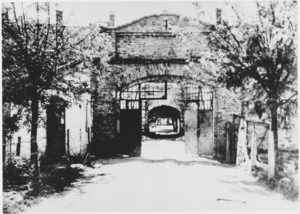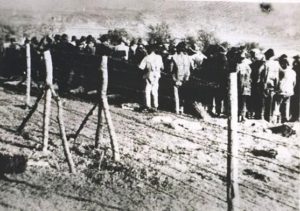A Brief History
From August 1941 to April 1945, hundreds of thousands of Serbs, Jews, and Romas, as well as anti-fascists of many nationalities, were murdered at the death camp known as Jasenovac. Estimates of the total numbers of men, women and children killed there range from 300,000 to 700,000. And yet, despite the scale of the crimes committed there, most of the world has never heard of Jasenovac.
Overthrow of Yogoslavia
The rise of fascist Croatia would begin to take root on October 9th, 1934 when Yogoslavia’s King Alexander was abrubtly assassinated while meeting with French Foreign Minister Loius Barthou. The assassin, Vlado Chernozemski, was a member of the International Macedonian Revolutionary Organization (IMRO) — a group working in alliance with the Croatian Ustase led by Ante Pavelic — which was sponsored by Italian fascist Benito Mussolini. The assassination of King Alexander set the stage for the Axis invasion of the Kingdom of Yogoslavia in 1941. After invading, occupying and dismembering the Kingdom of Yugoslavia, The Independent State of Croatia was established as a Nazi satellite state, ruled by the fascist militia known as Ustase. The new state was composed of Bosnia, Dalmatia, and Herzegovina as well as the old Croat province. Following the Nazi invasion and dismemberment of Yugoslavia in April 1941, the “Independent State of Croatia” was established as a pro-Nazi government. It was dedicated to a clerical-fascist ideology influenced both by Nazism and extreme Roman Catholic fanaticism. On coming to power, the Ustashe Party dictatorship in Croatia, led by Ante Pavelic, quickly commenced on a systematic policy of racial extermination of all Serbs, Jews and Romas living within its borders.
One of the first acts Ustase leader Dr. Pavelic set in motion was the banning of all political parties and completely prohibiting of any public meetings. On June 6th, 1941 Pavelic met with Adolf Hitler to discuss diplomatic negotiations between Axis and Balkan leaders. After the meeting with Hitler, Fascist Croatia immediately began commiting violent genocides against Serbs, Jews, and Roma. The atrocities commited by the Ustase of complete racial slaughter and forced religion “shocked” even the German Nazis.
The Camps
Jasenovac was established by the Ustase and was never controlled by Nazi Germany. Jasenovac was actually a complex of five major and three smaller “special” camps spread out over 240 square kilometers (150 square miles) in south-central Croatia.

The Dark Secret
Jasenovac is also known for having been one of the most barbaric death camps of the Holocaust for the extreme cruelty in which its victims were tortured and murdered. Jasenovac was not the only death camp in fascist occupied Yugoslavia, but it was by far the largest and the one in which a majority of the some one-million victims of racial genocide in World War II fascist Croatia were exterminated. But its significance also lies in the way in which the crimes have been concealed. Historians have called Jasenovac “the dark secret of the Holocaust” and “the suppressed chapter of Holocaust history.” Public recognition of the tragedy that occurred there has been suppressed either partially or completely by governments and institutions for a variety of reasons. Arthur Hefner, a German transport officer for work forces in the Reich, wrote on November 11, 1942 of Jasenovac: “The concept of the Jasenovac camp should actually be understood as several camps which are several kilometers apart, grouped around Jasenovac. Regardless of the propaganda, this is one of the most horrible of camps, which can only be compared to Dante’s Inferno”.
There is much difficulty determining the number of victims due to several factors such as the destruction of documents, inaccessibility to remaining documents, postwar partisan scholarship and journalism, which is influenced by ethnic tension, religious prejudice, and ideological conflict. The Ustasha were also known to kill new arrivals immediately without adding them to files. This was particularly true for those arriving from Slavonia, Srem and Kozara. As more information becomes available, we hope to have more accurate estimations in the future.
It was only 20 years later, in 1965, under pressure of the victims’ families and relatives, that the building of a monument was begun – a stone flower of which its author, engineer Bogdan Bogdanovic, said that, “it suggests the idea of overcoming suffering and insanity”. A few years later, the Open Memorial Museum was built, the graveyards were put in order, and the labor organization named Jasenovac Memorial Park was formed, which functioned until the beginning of the next war in 1991 and is the largest graveyard in the Blakins.
Even before the beginning of the new war in 1991, the Croatian authorities reduced the financing of the Jasenovac Memorial Park and declared Lonjsko polje a natural protected area, probably in order to turn the attention from the victims to the flora and fauna of the region. Croatian propaganda and Franjo Tudjman himself tried to minimize the crime with numerous articles, “studies” and statements, asserting that there were “not more than” 20,000-50,000 victims in Jasenovac.
At the end of September 1991, the Croatian Army entered the Jasenovac memorial park by force. According to the Hague Convention on the protection of historical and cultural monuments, the Croatian Army severely broke the agreement by entering the protected area. Although the international public informed about desecration of the memorial park. there was not much of a response.
The Serbian forces liberated Jasenovac Memorial Park on October 8, 1991. During the withdrawal the Croatian Army placed explosives blew up the bridge on the Sava River which connected the two parts of the Memorial Park; they also blew up the graves, destroyed the Museum artifacts and stole the Museum equipment. Due to the courage and enthusiasm of individuals who worked at the Memorial Park, some historical materials and objects were saved.
